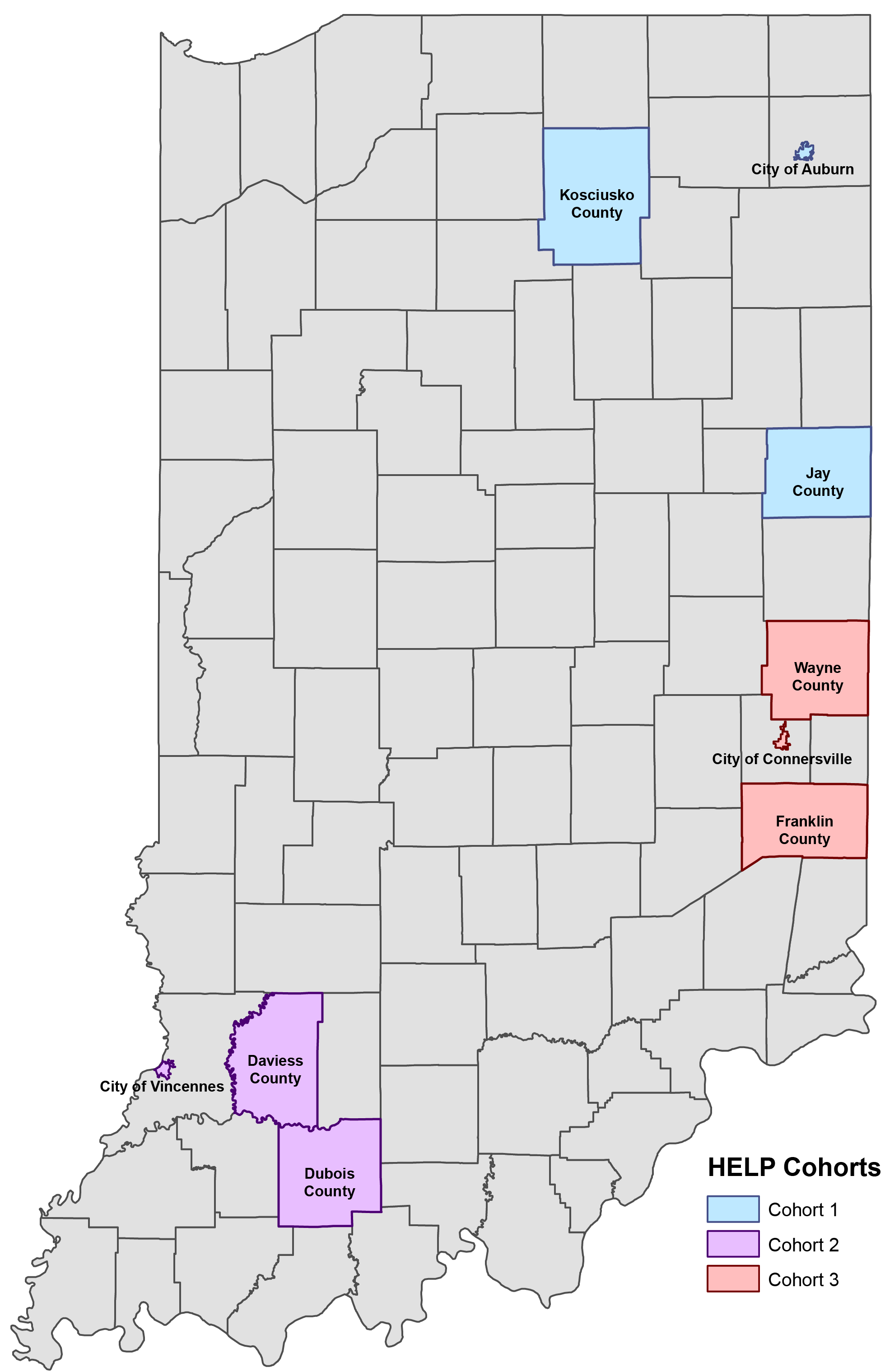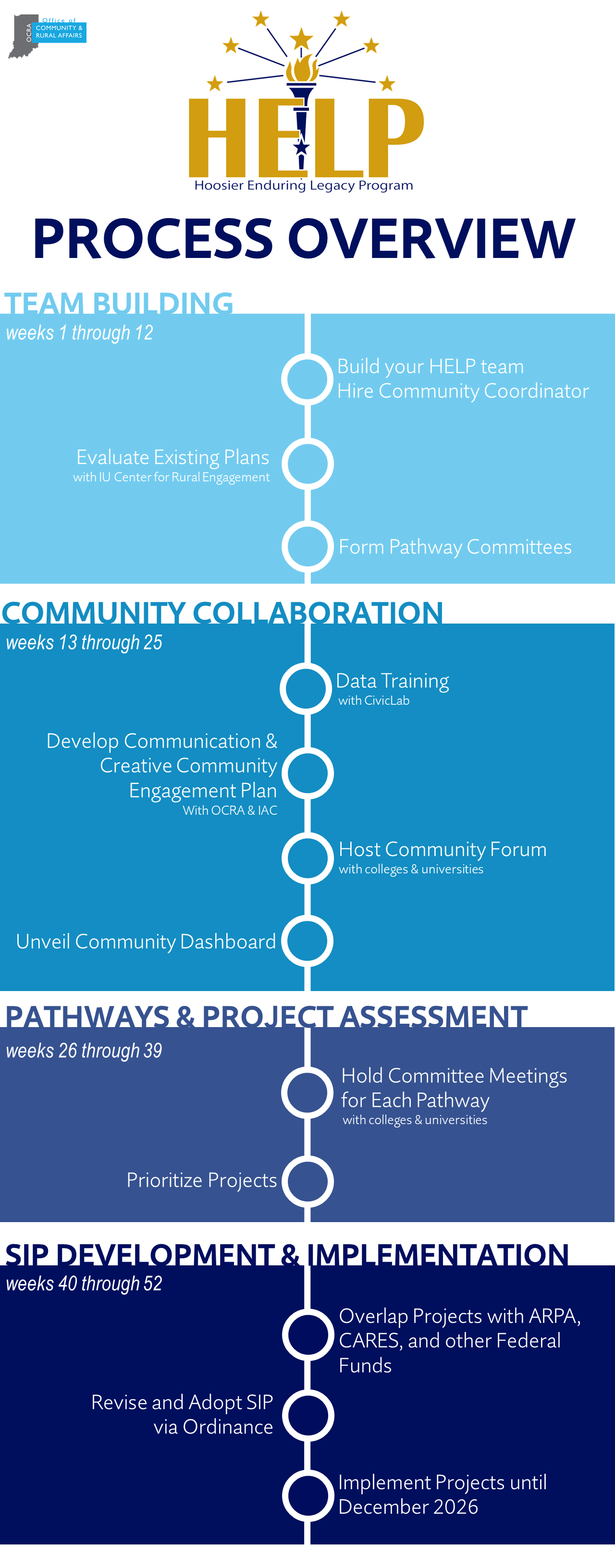HELP Communities
Cohort 1:
- The City of Auburn
- Jay County
- Kosciusko County
Cohort 2:
- The City of Vincennes
- Daviess County
- Dubois County
Cohort 3:
- The City of Connersville
- Franklin County
- Wayne County
*Cohort 1 will begin the year-long HELP program in Jan. 2022.
*Cohort 2 will begin the program in the summer of 2022.
*Cohort 3 will begin the program at the start of 2023.
Program Overview
In early 2020, OCRA put the Stellar program on hold, shifting priorities to help communities address the immediate impacts of the COVID-19 public health emergency. OCRA collaborated with the Purdue Center for Regional Development, the Indiana University Center for Rural Engagement, the Ball State University Indiana Communities Institute, Ivy Tech Community College, and other state partners to offer a new program to Hoosier communities statewide.
The Hoosier Enduring Legacy Program melded the pillars of OCRA’s Stellar initiative into a program that capitalized on the successes of previous efforts, while addressing the environment of Hoosier communities. This program supported communities directly by building capacity, creating a peer network system between communities participating in the program, developing a strategic investment plan and providing access to set-aside funding.
Through HELP, OCRA and its partners employed community engagement, prior planning efforts, and asset building strategies to reengage communities in preparing for the future while building local leadership capacity. The program amplified the impact of the Coronavirus Local Fiscal Recovery Funds, or CLFRF, of which $1.28 billion was allocated directly to Indiana communities through the American Rescue Plan Act, or ARPA.
HELP was a 52-week process culminating in a dynamic Strategic Investment Plan rooted in four pathways:
- Advancing e-Connectivity
- Promoting Community Wellness
- Enhancing Quality of Place
- Strengthening Local Economies
The HELP process and implementation of the resultant Strategic Investment Plan ultimately sought to build long-term capacity, develop attainable projects and leave a legacy in the community.
Expected Program Impact:
- Building Community Capacity through a local Community Coordinator position to guide the community through the program process and SIP implementation
- Welcoming Your Community Back Home by reconnecting to the larger community through creative engagement opportunities
- Peer Networking with other HELP Communities as well as various state agencies
- Strengthening ARPA Confidence through in-depth training on eligible uses of CLFRF with OCRA
- Training and Technical Assistance from OCRA, institutions of higher education, and statewide leaders in community development
- Strategic Investment Plan & Dashboard that includes high-quality data prepared about your community
- Access to set-aside funding for participatory budgeting project and SIP implementation from OCRA and other statewide partners
Community Expectations:
Local Unit of Government Responsibilities:
- Building a Core Team, as well as four separate Pathways Teams with input from the Core Team
- Planning, promoting and hosting a Community Forum and other diverse community engagement opportunities
Financial:
- $20,000 local match to fill a Community Coordinator position
- Communities are required to supply a $20,000 local match to fund this position, and they are encouraged to provide a minimum $40,000 to support this position in subsequent years for SIP implementation.
- Proof of Match and intent to create this position through an adopted local resolution is required with application submission.
- Minimum 30% of the community’s CLFRF allocation to projects in the SIP
- OCRA will match the community investment 1-1 for the implementation of SIP projects (up to $1 million).
Time:
- Participation by the Local Unit of Government is key to the success of the program. Communication with all State partners will be essential throughout the 12-month process. Additionally, defined meetings include:
- 4 Core Team Meetings
- 2-8 Pathways Meetings
What can be funded?
The SIP includes projects that align with the guidelines of the eligible uses of CLFRF as outlined by the American Rescue Plan Act. Broadly, this includes:
- A response to the public health emergency caused by or the negative impacts directly attributable to COVID-19;
- Any provision of government services to the extent of the reduction in revenue;
- Providing premium pay to essential workers;
- Necessary investments in water, sewer, or broadband infrastructure; and
- Direct aid to Qualified Census Tracts (QCTs) or other communities adversely impacted by the public health crisis.
For more information on the American Rescue Plan Act, please visit the links below or this toolkit developed by OCRA
For more information on the CDBG CARES Act (CDBG CV), please visit the CDBG CARES Act webpage or view the CDBG CV Toolkit developed by OCRA.
Funding Note:
- CARES Act (CDBG CV) funds from OCRA, as well as other funding sources from our state partners, will be available for SIP implementation to communities that complete HELP.

